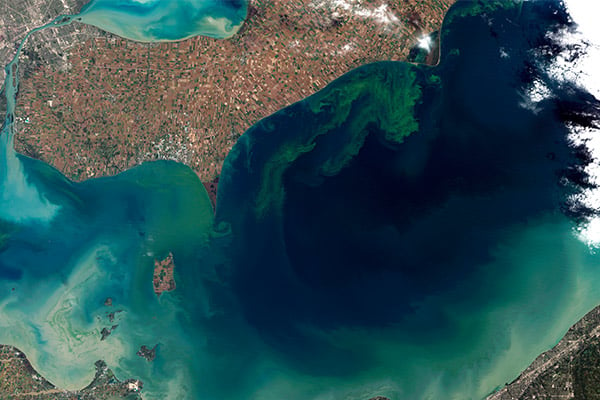High levels of rainfall this spring have researchers worried over the resulting toxic algae bloom in Lake Erie, with experts anticipating a significant bloom for this season.
Algae blooms, largely a result of nutrient runoff, cause dead zones in waterways – low oxygen areas that cannot support aquatic life and have a number of other adverse effects. Dead zones have been a growing concern among scientists and those who rely on water bodies in recent years, as their increasing occurrence and severity has brought resulting water quality issues to light.
In their recently released seasonal forecast, the National Oceanic and Atmospheric Administration (NOAA) anticipates a near-record bloom season for Lake Erie in 2017, a result of heavy May rainfall. This has brought concerns about dead zones into the spotlight once again, with many calling for change.
This algae bloom, indicated by the green “clouds” jutting out from the Northern shore, was taken in 2011 and was the worst algae bloom Lake Erie had experienced in decades.
Fertilizer Runoff: Feeding the Algae Problem
Unfortunately, Lake Erie is not a unique scenario; dead zones are a global problem and are expected to worsen.
While dead zones can occur naturally, their increased occurrence and severity has been attributed to human activity, largely, pollution from nutrient runoff, especially from agricultural sources such as fertilizer and manure.
Nitrogen and phosphorus runoff essentially feeds the algae, causing it to grow out of control. The massive algae bloom blocks sunlight and takes up oxygen, killing the plants beneath it. When the algae dies and decomposes, the oxygen in the area is used up, creating a dead zone devoid of life.
Dead zones can be found in various water bodies around the world, with major bloom activity documented in the Gulf of Mexico, the Baltic Sea, and more. In the recent past, the Metropolitan Sewerage District of Green Bay reported that the dead zone may already consume up to 40% of Lake Michigan’s Green Bay.
Compounding fears over dead zones and their associated effects, is that heavy rainfall, anticipated to be commonplace in the face of climate change, increases nutrient runoff, which worsens the algae problem.
Algae blooms also worsen with warming weather, another anticipated effect of climate change.
A new study published in Science looked at nitrogen loading in the continental U.S. from the anticipated increase in rainfall resulting from climate change. The study examined various scenarios of climate change and found nitrogen loading to increase in all of them.
The Effects of Algae Blooms & Dead Zones
Algae blooms and their impending dead zones can have devastating and widespread effects on marine life, threatening aquatic ecosystems and resulting in a number of subsequent effects on both the surrounding ecology and economy.
Effects on Marine Life
The effects of dead zones on aquatic life are catastrophic. Though some wildlife may be able to escape from dead zones, many organisms are suffocated by the low oxygen conditions.
Dead zones are also uninhabitable, resulting in a loss of habitat for aquatic life. Furthermore, they can negatively impact reproductive conditions for marine organisms, increasing the threat to delicately balanced ecosystems. Major die-offs of food sources can quickly propagate through the food chain.
Effects on Drinking Water
Algae blooms can also affect the quality of drinking water, with some containing bacteria that are toxic to humans and animals, causing a variety of adverse effects.
In 2014, an algae bloom in Lake Erie formed directly over Toledo, Ohio’s intake pipe, contaminating the city’s drinking water and forcing residents under a do not drink – do not boil mandate that lasted 3 days. This was not the first water ban resulting from dead zones that Ohio has seen.
Effect on Humans
In addition to drinking water contamination and its associated impact, algae blooms can affect humans in other ways as well.
Some algae blooms contain harmful bacteria that can become concentrated in filter feeders such as shellfish. When consumed by humans in enough concentration, the bacteria can cause a number of health effects, including seizures, memory loss and more.
Additionally, the impact of changing ecosystems can adversely affect recreation and tourism, discouraging swimming, fishing, and other activities that attract people to waterways. This can put communities that rely on water-related recreation, industry, and tourism at risk.
Reducing Algae Blooms from Fertilizer Runoff
The problem of dead zones is a complex issue with many factors coming into play. As such, the ability to effectively address dead zones from algae blooms will require a multi-faceted approach bringing together both legislation and applied technology around reducing nutrient runoff.
Legislation
Implementing effective and actionable legislation will be a key factor in the fight against algae.
With their long history in dealing with dead zones, the state of Ohio is no stranger to legislative efforts aimed at mitigating algae blooms. In their most recent efforts, Ohio Governor Kasich signed Senate Bill 1, which, among other things, set forth guidelines around manure and fertilizer application to help reduce nutrient runoff from agricultural sources. Additionally, government officials in Ontario, Canada, Ohio and Michigan joined together and set a goal to reduce the amount of phosphorus entering Lake Erie by 40% by 2025.
Earlier this year, Democratic Florida Senator Bill Nelson proposed a bill titled Harmful Algal Bloom and Hypoxia Research and Control Amendments Act of 2017. The bill proposes to amend the Harmful Algal Bloom and Hypoxia Research and Control Act of 1998 in order to address the growing algae bloom issue, which Floridians have become all too familiar with.
The bill, which is still under consideration, would allow severe algae blooms to be considered an event of national significance, opening the door to federal funding for impacted areas. The bill would also provide $22 million in annual support to further a better understanding of the causes and resolutions for algae blooms from 2019 through 2023.
Technology
Legislation around managing nutrients will be essential in meeting nutrient loading goals, but it can’t solve the problem alone; solutions aimed at resolving nutrient runoff are needed to aid in meeting these goals.
With runoff from fertilizers and manure being identified as major contributors, it’s easy to point the proverbial finger at commercial fertilizers and manure, but eliminating these nutrient sources altogether is not an option; both commercial fertilizers and manure are a valuable source of nutrients, essential to meeting food security needs. Considering the estimated global population of more than 9 billion people by the year 2050, the role of these materials is likely to only grow in importance as the world figures out how to feed a booming population with less arable land.
A granulated manure fertilizer
Many factors influence the effective management of nutrients. The 4R Nutrient Stewardship (4R) concept, which focuses on delivering the right nutrients, at the right rate, at the right time, and in the right place, is a critical concept in effectively addressing nutrient runoff, and one which the state of Ohio recommends growers follow.
Precision agriculture, or the practice of digitally mapping out the nutrient needs of a field and then using variable rate technology to distribute the precise amount of nutrients exactly where needed, is a growing trend in the agriculture industry, and one that intertwines closely with the concepts of 4R.
According to the International Plant Nutrition Institute, the implementation of precision agriculture technologies significantly increases the ability of growers to follow the 4R Nutrient Stewardship concepts.
At its best, optimal nutrient management is both a solution for growers and the environment: growers are able to fully realize the nutrient value of what they apply while fostering conditions for maximum yield, and nutrients are less likely to run off into waterways to feed harmful algal blooms.
A granular nutrient product is a critical component to the practice of precision agriculture, allowing for precise dispensing of nutrients.
Reducing Fertilizer Runoff Through Manure Granulation
The practice of granulating manure can also aid in the fight against runoff. A granular manure does not add additional moisture to the soil like raw manure does, lessening the chance for nutrients to leave the soil as runoff. Additionally, a dry, granular product is more easily stored for later use than raw manure, and makes following a nutrient management program much easier.
Interest around granulating manure has been on the rise as large-scale farms grapple with how to effectively and sustainably manage increasing amounts of manure, while utilizing the valuable nutrients it holds.
Conclusion
Dead zones brought on by harmful algal blooms are threatening waterways around the world, putting entire ecosystems, human health, and economies at risk. Adding to concerns is the promotion of algal blooms caused by anticipated changes in climate patterns resulting from climate change.
While a multi-faceted approach is needed, legislation combined with the application of various technologies, will be paramount to protecting waterways from dead zones going forward. Largely attributed to runoff from agricultural sources, the efficient management of nutrients is more critical than ever before, with precision agriculture and manure granulation playing an important role.
FEECO has been a pioneer in the fertilizer industry since 1951. We use our expertise in organic and inorganic fertilizer granulation to combine advanced products with modern agronomic principles. Our involvement in the Sustainable Phosphorus Alliance embodies our dedication to reducing nutrient runoff while ensuring that available nutrient sources are used to their full potential. For more information on our process design, material testing services, or custom granulation equipment, contact us today.



